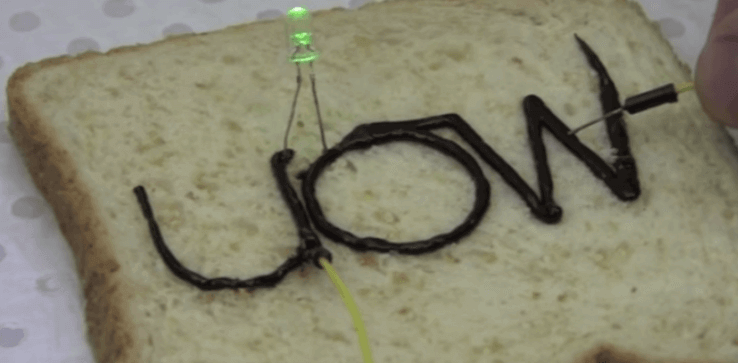Professor conducts 3D printing experiments with Vegemite, the yeasty breakfast spread. It tastes delicious… and it conducts electricity?!
Vegemite is one of those foods that is far more infamous than actually popular. It’s a dark brown food paste made from brewers’ yeast extract with various vegetable and spice additives. People’s reactions upon first tasting it veer from extreme devotion to extreme disgust.
This story begins in Australia — the country of origin for Vegemite — where Professor Marc in het Panhuis from the ARC Centre of Excellence for Electromaterials Science is researching soft and edible materials for applications in “soft robotics” and biomedicine. He had an intriguing idea; Vegemite is a food product commonly found on every breakfast table and cupboard… but can it do more?
According to his notes, Vegemite:
“…Contains water so it’s not a solid and can easily be extruded using a 3D printer. Also, it’s salty, so it conducts electricity.”
In other words, Vegemite could be used to complete a circuit between an LED and a battery, making Vegemite-powered-goods the new potato clock or lemon battery for grade schoolers.
3D Printing Vegemite Electronics
He created a “breadboard,” a construction base designed for prototyping electronics. Using a 3D printer and a syringe, he printed the letters UOW (Initials for the Univeristy of Wollongong, home to the centre of excellence) onto a slice of white bread. Thereafter, it was shown that even simple Vegemite letters printed on bread could be used to conduct electricity.
Best of all, you can eat your project when you’re done.
If you’re stumped on how conductive Vegemite may be useful, in het Panhuis’s background in biomedicine may shed some light on the purpose of the experiment. The project has very real applications for the medical industry. Vegemite is not only be ideal for the printing of edible electronics, it can also be used to make “ingestible biomedical sensors that perform a function (in the stomach for example) and are then processed by the body in a natural way.”
Previously, in het Panhuis has already been experimenting with gelatin and creating non-toxic, digestible sensors. It seems Vegemite was the brown, sticky piece of the puzzle he’s been looking for. (Via: TechCrunch and VICE)
License: The text of "3D Printed Vegemite: Good for Breakfast and Medicine" by All3DP is licensed under a Creative Commons Attribution 4.0 International License.
